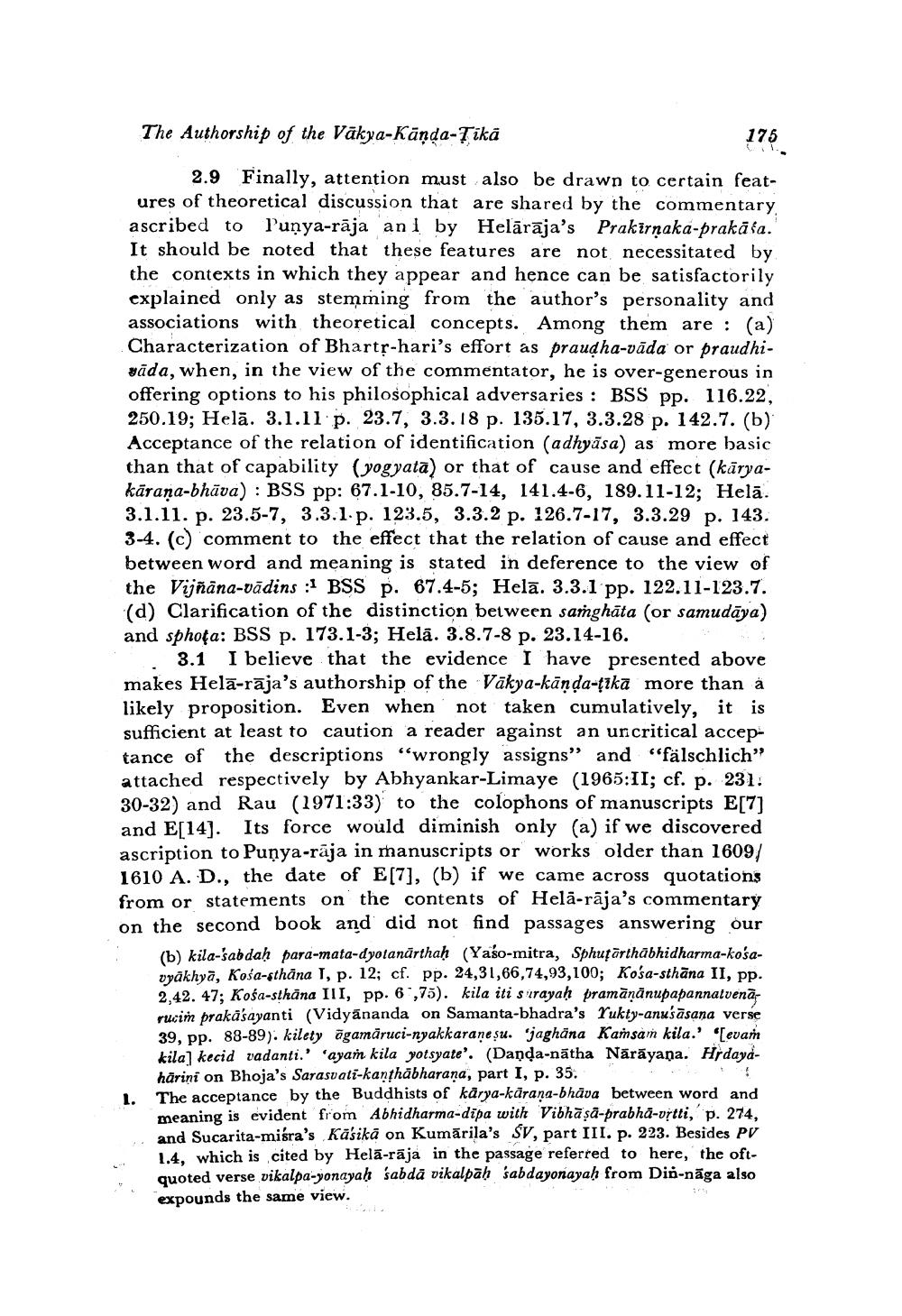________________
The Authorship of the Vākya-Kānda-Tikā
175
2.9 Finally, attention must also be drawn to certain features of theoretical discussion that are shared by the commentary ascribed to Punya-rāja ani by Helārāja's Prakirnaka-prakāśa. It should be noted that these features are not necessitated by the contexts in which they appear and hence can be satisfactorily explained only as stemming from the author's personality and associations with theoretical concepts. Among them are: (a) Characterization of Bhartr-hari's effort as praudha-vāda or praudhirāda, when, in the view of the commentator, he is over-generous in offering options to his philosophical adversaries : BSS pp. 116.22, 250.19; Helā. 3.1.11 p. 23.7, 3.3.18 p. 135.17, 3.3.28 p. 142.7. (b) Acceptance of the relation of identification (adhyāsa) as more basic than that of capability (yogyata) or that of cause and effect (kāryakārana-bhāva): BSS pp: 67.1-10, 85.7-14, 141.4-6, 189.11-12; Helā. 3.1.11. p. 23.5-7, 3.3.1. p. 123.5, 3.3.2 p. 126.7-17, 3.3.29 p. 143. 3-4. (c) comment to the effect that the relation of cause and effect between word and meaning is stated in deference to the view of the Vijñāna-vādins :1 BSS p. 67.4-5; Helā. 3.3.1 pp. 122.11-123.7. (d) Clarification of the distinction between samghāta (or samudāya) and sphoța: BSS p. 173.1-3; Helā. 3.8.7-8 p. 23.14-16.
... 3.1 I believe that the evidence I have presented above makes Helā-rāja's authorship of the Vākya-kānda-ţika more than a likely proposition. Even when not taken cumulatively, it is sufficient at least to caution a reader against an uncritical acceptance of the descriptions "wrongly assigns" and "fälschlich" attached respectively by Abhyankar-Limaye (1965:11; cf. p. 231. 30-32) and Rau (1971:33) to the colophons of manuscripts E[7] and E[14]. Its force would diminish only (a) if we discovered ascription to Punya-rāja in manuscripts or works older than 1609/ 1610 A.D., the date of E[7], (b) if we came across quotations from or statements on the contents of Helā-rāja's commentary on the second book and did not find passages answering our
(b) kila-sabdah para-mata-dyotanárthah (Yaso-mitra, Sphusārthābhidharma-kosavyākhyā, Kosa-sthāna I, p. 12; cf. pp. 24,31,66,74,93,100; Kosa-sthāna II, pp. 2,42. 47; Kośa-sthāna III, pp. 6,75). kila iti sırayaḥ pramāṇānupapannatvenarucim prakasayanti (Vidyānanda on Samanta-bhadra's Yukty-anu'sāsana verse 39, pp. 88-89), kilety ēgamāruci-nyakkarane su. 'jaghäna Kamsam kila.' '[evan kila kecid vadanti.' 'ayam kila yotsyate'. (Danda-nātha Nārāyana. Hrdaydhärini on Bhoja's Sarasvati-kanthabharana, part I, p. 35. The acceptance by the Buddhists of karya-karana-bhäva between word and meaning is evident from Abhidharma-dipa with Vibhāsā-prabhā-urtti,' p. 274, and Sucarita-misra's Käsikä on Kumārila's SV, part III. p. 223. Besides PV 1.4, which is cited by Helā-rāja in the passage referred to here, the oftquoted verse vikalpa-yonayah sabda vikalpah sabdayonayah from Din-nőga also expounds the same view.
1.




